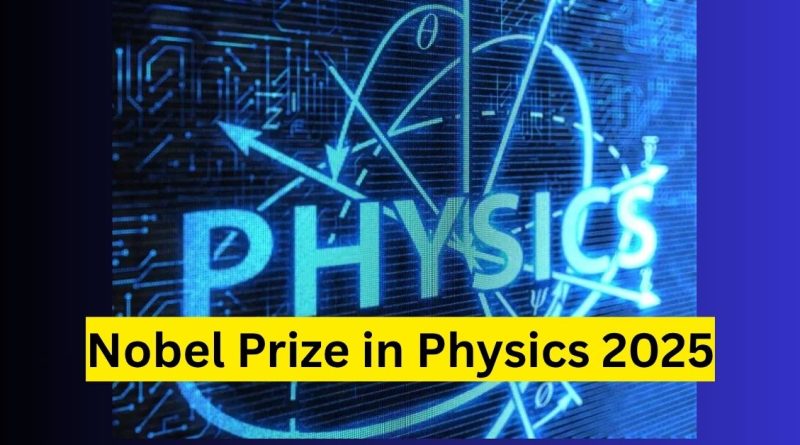Nobel Prize in Physics 2025 Recognizes Discovery of Quantum Effects in Electric Circuits
The Nobel Prize in Physics 2025 has been awarded jointly to John Clarke, Michel H. Devoret, and John M. Martinis for their groundbreaking discovery of macroscopic quantum mechanical tunnelling and energy quantisation in an electric circuit. Their pioneering research has connected the invisible world of quantum mechanics to the physical circuits that power modern technology, laying the groundwork for today’s quantum computers.
From Microscopic Oddities to Macroscopic Reality
- Quantum mechanics has long fascinated scientists with its strange phenomena such as superposition, entanglement, and tunnelling the ability of a particle to pass through a barrier it could not cross by classical means. Traditionally, these effects were observed only in microscopic systems like atoms or electrons.
- The 2025 Nobel laureates sought to answer a bold question: Can quantum effects exist in larger systems, visible to the human eye and made up of billions of particles? Their experiments proved that the answer is yes.
- Clarke, Devoret, and Martinis used superconducting circuits containing Josephson junctions, which consist of two superconductors separated by a thin insulating barrier. Despite containing countless electrons, these circuits behaved as single quantum systems.
- In their experiments, they observed macroscopic quantum tunnelling, where the entire circuit shifted from one energy state to another, a phenomenon that would be impossible according to classical physics. They also found evidence of energy quantisation, showing that these circuits absorbed and emitted energy in discrete amounts — a hallmark of quantum behavior.
- Their work revealed that quantum mechanics is not limited to the microscopic world. It can govern systems large enough to build, observe, and control in the laboratory.
The Laureates and Their Scientific Journey
- John Clarke was born in Cambridge, United Kingdom, in 1942. After completing his doctorate at the University of Cambridge, he joined the University of California, Berkeley, where he became a world authority on superconductivity and quantum electronics. His early experiments with superconducting circuits opened new paths in quantum research.
- Michel H. Devoret was born in Paris, France, in 1953. He studied at the University of Paris-Sud and later worked at Yale University. Devoret has been a leading figure in the development of quantum circuits, including advanced qubit designs such as the transmon. His research has been vital for the evolution of superconducting quantum computers.
- John M. Martinis was born in 1958 in the United States and completed his PhD at the University of California, Berkeley, under Clarke’s supervision. He later joined the University of California, Santa Barbara, and led the quantum hardware team at Google. His team built some of the first devices to demonstrate quantum supremacy, proving that a quantum computer could solve specific problems faster than a classical computer.
- Together, these three scientists bridged the gap between fundamental physics and real-world technology. Their experiments laid the foundation for the superconducting qubits used in most modern quantum computers.
From Discovery to Technology
- The Nobel Committee described their work as “revealing quantum physics in action.” The experiments showed that the laws of quantum mechanics apply not only to the smallest particles but also to large systems that can be manufactured and measured.
- Their discoveries are deeply connected to modern technology. Quantum mechanics is the foundation of semiconductors, lasers, and digital electronics, but the laureates took it further by showing how quantum behavior can be engineered into circuits. This idea led to the development of quantum computing, quantum sensing, and quantum communication technologies.
- Superconducting qubits, which rely on Josephson junctions, are now among the leading platforms for building quantum computers. These qubits use the same principles discovered by Clarke, Devoret, and Martinis to encode information in quantum states that can be manipulated and measured.
- Beyond computing, their work influences other fields. Quantum sensors based on superconducting circuits are used to measure magnetic fields, detect gravitational waves, and even search for dark matter. The same principles may one day enable ultra-secure communication networks that use quantum encryption.
Deeper Meaning of Their Discovery
- The laureates’ experiments go beyond technology. They have changed how scientists think about the boundary between the quantum and classical worlds. Their results prove that there is no strict dividing line between the two quantum mechanics can describe both the smallest particles and large engineered systems.
- This raises profound philosophical and scientific questions. Where does classical behavior begin? How can we maintain quantum coherence in large systems? Their work shows that the key lies in careful engineering isolating a system from noise and keeping it at extremely low temperatures to preserve its quantum state.
- By demonstrating that macroscopic systems can behave quantum mechanically, Clarke, Devoret, and Martinis brought the mysterious world of quantum mechanics into the realm of practical engineering.
Challenges and Future Directions
- Although the laureates’ discoveries have led to major progress, significant challenges remain. Building stable quantum devices is extremely difficult. Quantum systems are sensitive to even the smallest disturbances, and maintaining coherence over time requires near-perfect control.
- Superconducting circuits must operate at temperatures close to absolute zero, and each qubit must be carefully shielded from environmental noise. Scaling up from a few qubits to thousands or millions the level needed for practical quantum computing is a major scientific and engineering challenge.
- Researchers around the world are now building on the laureates’ work, exploring new materials, circuit designs, and error-correction methods to make quantum systems more reliable and scalable. Competing approaches, such as trapped ions and photonic qubits, show that there are multiple paths toward a quantum future, but all rely on principles discovered through superconducting circuits.
A Quantum Future
- The Nobel Prize in Physics 2025 celebrates not just a scientific milestone but also the dawn of a new technological era. Quantum mechanics has already transformed our understanding of the universe, and thanks to these discoveries, it is now shaping the technologies of tomorrow.
- Quantum computing promises to revolutionize fields such as materials science, medicine, and cryptography by solving problems that are impossible for classical computers.
Quantum sensing could bring breakthroughs in navigation, imaging, and measurement precision.
Quantum communication could ensure unbreakable security through quantum encryption and teleportation protocols. - All of these advances trace their origins to the fundamental experiments that showed quantum effects can exist in circuits large enough to hold in your hand.
Conclusion
The 2025 Nobel Prize in Physics honors John Clarke, Michel H. Devoret, and John M. Martinis for discoveries that expanded the boundaries of quantum mechanics. Their experiments proved that quantum effects are not limited to the microscopic world but can manifest in macroscopic systems a revelation that continues to inspire scientists and engineers worldwide.
Their research has opened the door to practical quantum technologies that may transform computing, communication, and sensing in the decades to come. This Nobel Prize reminds us that quantum mechanics, despite being a century old, still holds endless surprises and possibilities for shaping the future.




